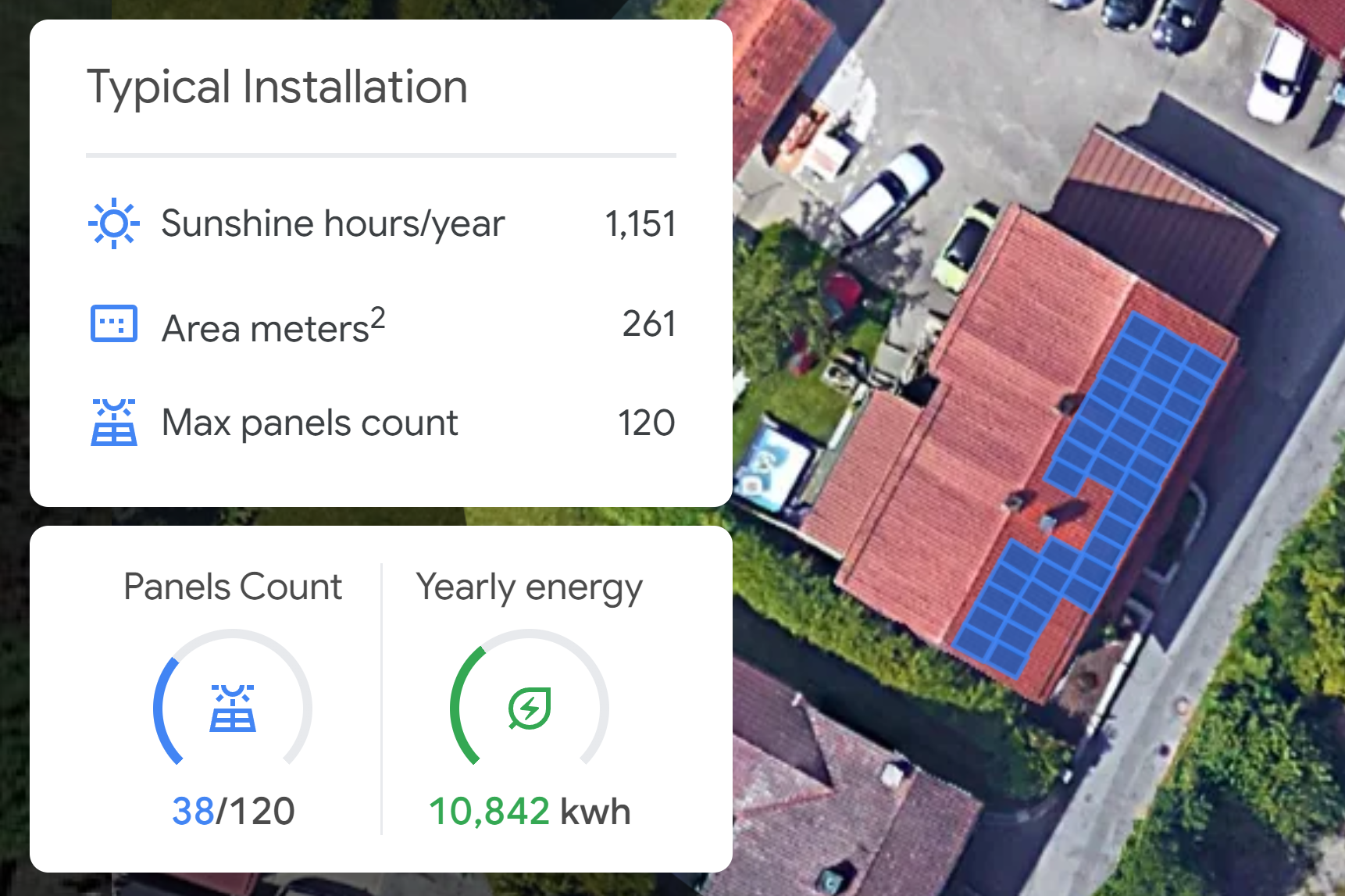
Solar power systems, known as photovoltaics (PV), harness the sun’s power and transform it into usable electricity for your household.
With solar panel installation, you have the capability to produce your own sustainable energy.
Solar panels work by converting sunlight into electricity. Here’s a simplified explanation:
Each solar panel is made up of many solar cells, which are usually made from silicon. These cells are designed to absorb sunlight.
When the sunlight is absorbed by the solar cells, it generates a direct current (DC) electricity due to the photovoltaic effect. The photovoltaic effect occurs when photons from sunlight knock electrons into a higher state of energy, creating electricity.
Since most homes and electrical grids use alternating current (AC) electricity, the DC electricity generated by the solar panels is passed through an inverter to convert it to AC electricity.
Once converted to AC electricity, it can be used to power your home’s electrical systems and appliances. Any excess electricity generated can be stored in a battery system for later use or fed back into the power grid, depending on your system setup and local policies.
In essence, solar panels allow you to harness the sun’s energy and convert it into electricity that can be used to power your home, reducing your reliance on traditional power sources and your impact on the environment. read more on our blog.
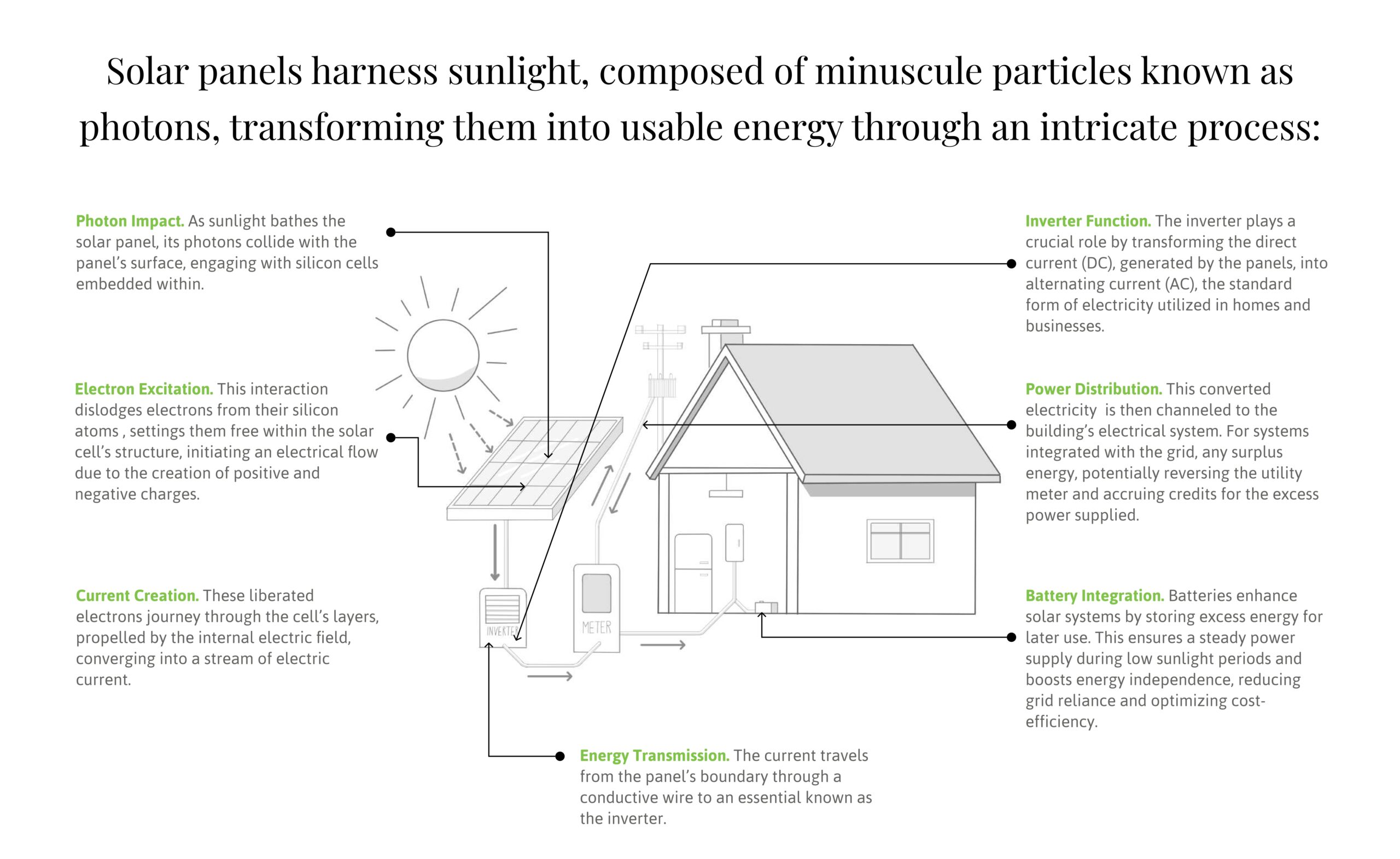
Determining if you have enough space for solar panels involves several factors. Here’s a checklist to help you assess your situation:
Ideally, you need a relatively large, unobstructed area on your roof. The amount of space required depends on your energy needs and the efficiency of the panels. As a rough estimate, a typical home solar system might require between 15 and 25 square metres of roof space.
Solar panels perform best on south-facing roofs (in the Northern Hemisphere) or north-facing roofs (in the Southern Hemisphere) with a tilt angle between 15 and 40 degrees. East or west-facing roofs might still be viable but could be less efficient.
Check for potential shading from trees, nearby buildings, or other obstacles, especially during peak sunlight hours. Shading can significantly reduce the efficiency of your solar panel system.
Ensure your roof is in good condition and can support the weight of the solar panels. It might be wise to repair or replace an old or damaged roof before installation.
If your roof isn’t suitable, consider other locations such as ground mounts in a yard or garden, if space and conditions permit.
To get a precise assessment use our solar calculation tool.
In the UK, installing solar panels (PV systems) on your home generally falls under “Permitted Development Rights,” which means you usually don’t need to apply for planning permission, provided certain conditions are met. However, there are some circumstances where you might need permission:
If your home is a listed building, you will need to obtain listed building consent.
In conservation areas or near World Heritage Sites, installations on the front of the property or the site that faces the road might require permission. Additionally, there may be restrictions on the appearance or height of the panels.
While you might not need planning permission, installations must comply with building regulations. This includes ensuring the roof’s structure can support the panels and that the installation meets electrical safety standards.
If your property is leasehold, you may need permission from the freeholder or management company.
The installation must not protrude more than 200mm beyond the plane of the roof and should not be higher than the highest part of the roof, excluding chimneys.
Given these conditions, it’s always a good idea to check with your local council’s planning department before proceeding with an installation. They can provide specific guidance based on your property and local regulations. Additionally, a reputable solar installer should be able to advise you on these matters and assist with any necessary applications.
The path a photon takes from the sun to a functioning appliance in a home isn’t a trivial one. The installation and integration of solar panels involve a complex web of engineering, policy, and strategic planning that demands meticulous attention to detail.
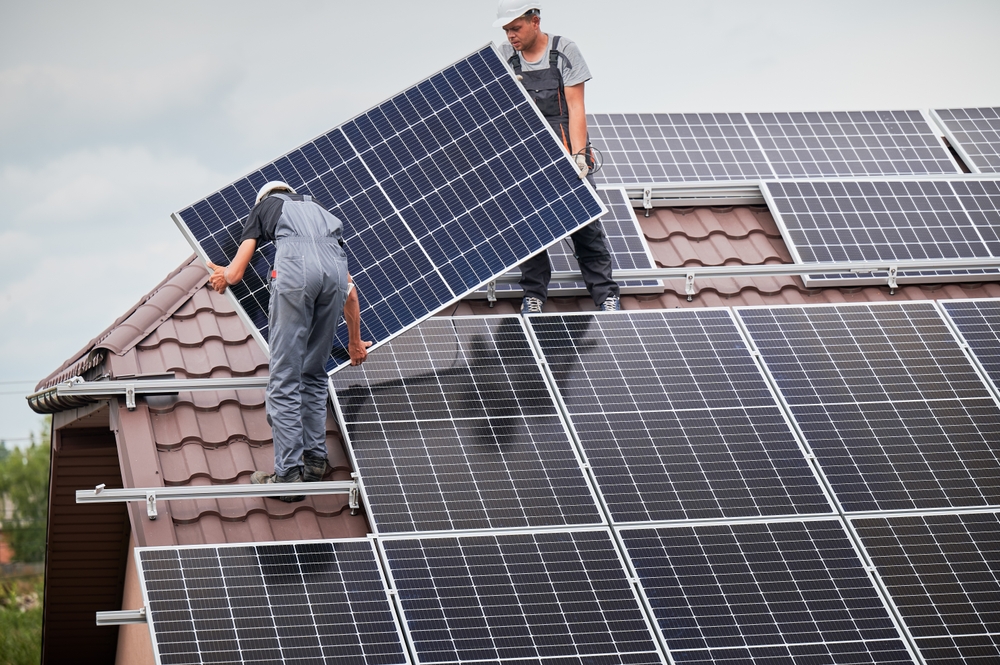
Before the first panel is even unpacked, a Solar Spectrum Audit becomes the sunlight map that guides a successful installation. Site assessment tools and methodologies have evolved dramatically, becoming increasingly sophisticated and data-driven. We’ll unveil the AI and GIS tools that are mapping the future of solar installations with precision and foresight.
The solar mounting system is the unsung hero of every solar array. Ground mount systems, roof mount racks, and the increasingly popular solar carports are redefining the landscape (sometimes quite literally) of solar deployment. It is a marriage between architecture and engineering, where the optimal tilt and azimuth brings that seemingly ineffable quality called ‘solar gain’. What best practices can ensure these systems withstanding the vagaries of nature and time?
Read more on our blog.
Inverters are the interpreters of the solar language, converting the DC output of solar panels into the AC that appliances crave. With breakthroughs in inverter technology like micro-inverters and power optimizers, the rate of loss has plummeted, and efficiency has surged. We’ll also discuss grid-tie inverters, their role in grid stability, and the potential of islanding to prepare for unexpected grid failures. read more about inverters.
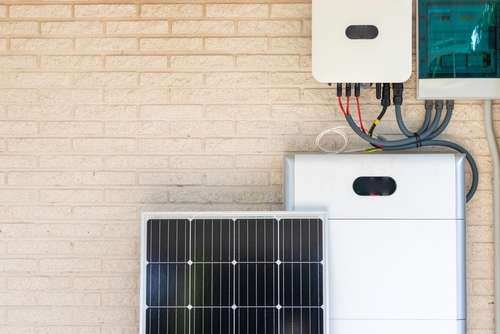
Solar PV (photovoltaic) grid integration in the United Kingdom involves the process of connecting solar power systems to the national grid to enable the distribution of electricity generated from solar energy. This process is critical for leveraging solar energy as a significant component of the UK’s renewable energy portfolio. The integration of solar PV into the UK grid encompasses several key aspects:
The UK government has established various policies and regulatory measures to encourage the adoption of solar energy. These include incentives like the Feed-in Tariff (FiT) scheme (which has now ended but was instrumental in the initial growth of solar PV installations) and the Smart Export Guarantee (SEG) that replaced it, ensuring that small-scale generators get paid for exporting renewable energy back to the grid.
Connecting solar PV systems to the grid requires adherence to technical standards and regulations to ensure safety, reliability, and compatibility. Distribution Network Operators (DNOs) are responsible for managing these connections. They ensure that the solar PV systems do not negatively impact the grid’s performance, particularly in terms of voltage regulation and frequency stability.
To facilitate the effective integration of solar PV, advanced technologies are employed. These include smart inverters, which can help manage the flow of electricity and ensure stability, and energy storage systems, which can store excess energy generated during peak solar hours for use when solar generation is low. Additionally, demand-side response (DSR) programmes help to balance supply and demand on the grid by adjusting energy usage in response to grid conditions.
Integrating a high penetration of solar PV poses challenges such as intermittency and grid stability. The UK is exploring various solutions to these challenges, including the development of a more flexible grid system, investment in energy storage technologies, and the use of artificial intelligence and machine learning for better prediction and management of solar energy generation and demand.
Before proceeding with any formal application, it’s essential to conduct a preliminary assessment of the proposed site to determine its suitability for a solar PV installation. This involves considering factors like solar irradiance, roof space (for rooftop systems), land availability (for ground-mounted systems), and any potential shading or other issues that might affect performance.
For smaller installations (typically under 3.68 kW for single-phase supplies and 11.04 kW for three-phase supplies in domestic settings), you may only need to notify the local Distribution Network Operator (DNO) after installation. However, larger systems usually require prior approval from the DNO, which involves submitting an application that includes technical details about the proposed system, such as its capacity, location, and how it will be connected to the grid.
In many cases, particularly for larger installations or those in sensitive locations (like conservation areas), you may need to obtain planning permission from the local authority. This process involves submitting detailed plans of the installation and may require consultation with neighbors or other stakeholders.
For systems under a certain size (typically those eligible for government incentives), it’s necessary to use Microgeneration Certification Scheme (MCS) certified equipment and installers. The MCS certification ensures that both the equipment and the installation meet specific quality and performance standards.
Solar electricity offers numerous benefits, making it an attractive option for many homeowners and businesses. Here are some key advantages:
Solar energy is a truly renewable resource available every day, unlike finite fossil fuels. It can be harnessed in all areas of the world and is available every day.
Generating your own electricity means you’ll need less from the grid, leading to lower electricity bills. The amount you save will depend on the size of your solar system and your electricity usage.
Solar energy has one of the lowest environmental impacts compared to other energy sources. It reduces greenhouse gas emissions and air pollutants, contributing to a reduction in your carbon footprint.
By generating your own electricity, you reduce dependence on fossil fuels and the national grid, enhancing energy security.
Many regions offer incentives for solar energy installation, such as feed-in tariffs or net metering, where you can sell excess electricity back to the grid.
Solar energy can be used for diverse purposes, including generating electricity (PV systems) or heat (solar thermal), and even for water distillation or to power satellites in space.
Solar energy systems generally require little maintenance, mainly keeping them relatively clean and having an occasional check by a professional. Most systems come with a 20-25 year warranty.
Advancements in solar technology are continually improving efficiency and lowering costs, making solar an increasingly accessible option.
Overall, solar electricity not only offers financial benefits but also contributes to a sustainable and environmentally friendly energy future.
Your solar PV system generates power even on overcast days, particularly during daylight. However, if your household consumption exceeds the production of your panels, especially at night when there’s no solar generation, you’ll need to draw power from the grid. Minimising your electricity consumption can lead to lower energy bills and a smaller carbon footprint. For those enrolled in a Smart Export Guarantee scheme, there’s a financial incentive for every unit of electricity sent back to the grid. It’s beneficial to switch off unused devices and steer clear of leaving them on standby.
Since your solar system is most productive during the day, it’s wise to schedule high-energy tasks like laundry, dishwashing, and ironing in these hours. For those often out during the day, utilising appliance timers can be an effective workaround.
Enhance your solar PV’s efficiency by pairing it with other renewable solutions like heat pumps or solar thermal systems, which can complement each other well. For instance, solar energy can power heat pumps, contributing to a cohesive renewable setup.Our Go Renewable online tool can guide you in selecting suitable renewable options for your home.
A PV diverter can significantly boost your consumption of self-generated solar electricity. It redirects any surplus power, which would otherwise go to the grid, to your immersion heater, thereby storing hot water for later use. While it may not cover all your hot water requirements, it can substantially decrease energy expenses.
Incorporating a PV diverter might add an approximate £800 to your overall installation costs. Discuss the possibility and the option of adding more panels for enhanced hot water provision with your installer. Alternatively, you could export the surplus energy back to the grid and possibly receive export payments under a Smart Export Guarantee.
Other sustainable hot water solutions include solar thermal systems or integrating a comprehensive heating system like a heat pump or biomass boiler.
Minimising your electricity consumption can lead to lower energy bills and a smaller carbon footprint. For those enrolled in a Smart Export Guarantee scheme, there’s a financial incentive for every unit of electricity sent back to the grid. It’s beneficial to switch off unused devices and steer clear of leaving them on standby.
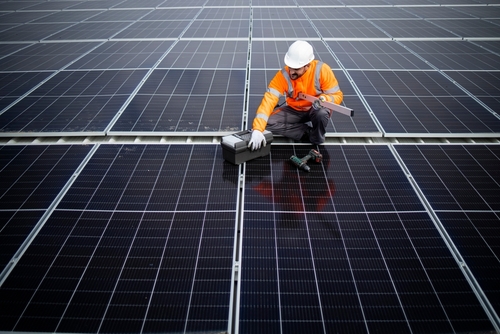
When your home solar PV system generates more electricity than you’re able to utilise or store, this excess can be sent back to the grid for others to use. To monetize this surplus, it’s essential to secure an arrangement that compensates you for the exported energy. For those who were part of the Feed-in Tariff scheme before its closure in March 2019, export payments are included. Otherwise, seeking an energy supplier that offers payment for the surplus energy is necessary.
The Smart Export Guarantee (SEG), established post the Feed-in Tariff scheme’s conclusion for new applicants, ensures that small-scale renewable producers are financially rewarded for the electricity they contribute back to the grid. The financial returns from solar PV are significantly enhanced under the SEG.
In Great Britain, the SEG remunerates you for your exported electricity, while in Northern Ireland, payments for surplus export (ROCs payment) are typically calculated based on your generation amount. Various providers facilitate this, and it’s advisable to compare their propositions to identify the most favourable one.
On average, a domestic solar PV setup with a capacity of 3.5kWp is priced at about £7,000. The total cost is contingent on the system’s size and any potential challenges in accessing your roof. Installation expenses might be mitigated if scaffolding is already present for other roof work or if the installation coincides with new construction. The choice between rooftop panels, tiles, or building-integrated panels also influences the cost, with rooftop panels being the most economical and tiles the priciest for a comparable setup.
The pricing for ground-mounted systems varies more due to factors like the mounting framework and its distance from your residence.
Use our online assessment tool to find out how you can benefit from solar panel PV installation
Typically, a household will utilise around 15-25% of the electricity produced by their solar system. This percentage can vary significantly depending on several factors, including:
To maximise the use of your generated electricity, consider installing a PV diverter switch. This device can redirect any excess electricity to heat water in your tank, providing hot water when needed. While solar energy alone might not cover all your hot water requirements, it can contribute to lowering your energy expenses.
Solar PV installations demand minimal upkeep. However, it’s important to monitor any nearby foliage to prevent shading over your setup.
In regions like the UK, panels angled at 15 degrees or above naturally stay clean thanks to rainwater, which aids in maintaining efficiency. Yet, for ground-mounted systems or in dustier locales, periodic cleaning might be necessary to prevent debris accumulation.
After installation, your provider should supply you with a maintenance guide, including essential checks to keep the system in peak condition, along with advice on identifying and resolving common issues. It’s beneficial if they can show you these procedures in person post-installation.
Monitoring your system’s output and comparing it with weather conditions will help gauge its performance and signal any potential issues.
While solar panels typically last over 25 years, the inverter may require replacement within that time frame, potentially costing about £800, subject to the system’s scale and manufacturer specifications. Some inverters offer remote monitoring capabilities, alerting you via email to any system malfunctions.
Inverter warranties usually start at five years and can often be extended to 15 years. Discuss the expected lifespan and the value of an extended warranty with your installer. Weigh the cost of an extended warranty against the potential expense of a new inverter in the future.
Before proceeding with a solar PV system installation, ensure you understand all maintenance needs as advised by your installer.
To estimate the annual savings or income for a solar PV system in London, South East England, with vs. without the Smart Export Guarantee (SEG), we need to consider several factors. The indicative savings are for a gas-heated, three-bedroom semi-detached property in the UK equipped with a hot water cylinder and a PV diverter. The system also results in a reduction of 0.89 tonnes of CO2 per year.
What does the SUNUTI community say?
